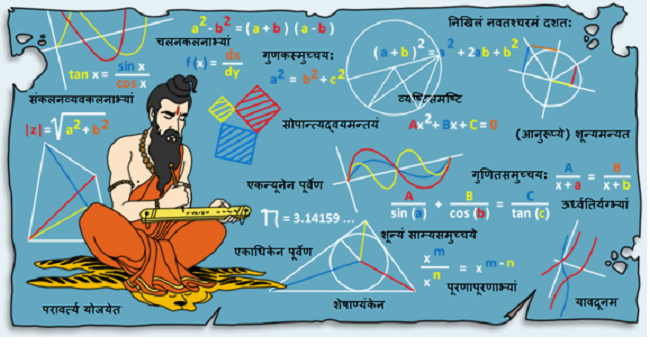The state of Gujarat is setting a new milestone in the Indian education system with a transformative move— introduction of Vedic mathematics in school education from the next academic year. Education Minister Jitu Vaghani made the big announcement on the occasion of the birth anniversary of renowned Indian mathematician Srinivasa Ramanujan.
With this, India has come closer to embracing an ancient knowledge base that makes arithmetic problem-solving easier and faster.
The genius of Vedic mathematics
Vedic mathematics is an ancient Indian method that makes mathematics simpler by integrating arithmetic operations into 16 `sutras’ or formulae. The 16 formulae were compiled by Jagadguru Swami Sri Bharathi Krishna Tirthaji Maharaj in a book published by him in 1965 and are believed to be a part of the parishishta (appendix) of the Atharva Veda.
By reducing the steps involved, it cuts the time needed to solve complex mathematical problems. It also creates multiple approaches for solving problems and obtaining an answer.
I understand that it is hard for you to trust what I am saying. Having spent a major part of student life solving complex mathematical problems, it becomes difficult to accept that there can be a quicker way of solving mathematics. So, let me give you a small demonstration.
How it works
What is 93 multiplied by 97? Well, most people would pick up their calculators or start using the conventional way of multiplying the two numbers, which will take some time.
Okay, so now we use Vedic mathematics. Both 97 and 93 are smaller than 10², that is 100, right? 97 is smaller by 3, and 93 is smaller by 7. So multiply 3 and 7, which is 21. Now, subtract 93 by 3 or 97 by 7, and in both cases, it will be 90. So, you get 90 and 21. Just join the two results, and you get 9021. That’s your answer. You can also use calculators if you want to cross-check.
Now, we take 105 and 108. This time you have two numbers that are greater than 10². 105 is greater by 5, and 108 is greater by 8. 5 multiplied by 8 is 40. This time you add 8 to 105 or 5 to 108— that is your choice. You get 113 in either case. Join the two results, that is, 11340. Mathematics just became easier, right?
Vedic mathematics has an answer to all of your complex arithmetic operations. I, of course, picked up multiplication which is one of the slightly easier concepts. But Vedic mathematics is actually quite simple and more evolved than British or modern mathematics that tends to be somewhat confusing and chaotic.
Vedic mathematics must be promoted
Just like Yoga, Vedic mathematics is a part of our ancient knowledge system. It is our cultural heritage and it is time that we embrace it.
However, till date, it has not been promoted in a big way. Vedic mathematics was never introduced as a part of the regular curriculum in our schools.
In fact, school kids rarely hear about Vedic mathematics. They get to know of it only in their teenage years, when they start preparing for competitive examinations. And till now, Vedic mathematics has been confined to private coaching centres that not everyone can afford.
But if you start teaching Vedic mathematics and kids get to improve their arithmetic problem-solving abilities at an early age, then India can create a huge talent pool of students with brilliant mathematical skills.
Time for India to assert her contribution to mathematics
Due to the colonial hangover and a sense of inferiority complex in the Indian education system, we continue to study mathematics as a subject invented by the West. Well, this is far away from the truth.
Mathematics on the Indian subcontinent has a history of 3,000 years. Countless Indian generations have been solving complex arithmetic problems, and it is no wonder that the first recorded use of the number zero happened in India.
India has made seminal contributions to the study of trigonometry, algebra, arithmetic, and negative numbers. Indian mathematician Bhāskara had, for example, delved deep into concepts relating to calculus, algebra, arithmetic, geometry, and trigonometry much before the Europeans.
Vedic mathematics is a part of the same knowledge bank. Those living in colonial hangover, believe that traditional Indian mathematics is ‘unscientific’ by their standards. This is the very reason why the left-liberal cabal of the Indian education system never allows Vedic mathematics to become a part of India’s regular school curriculum.
But just because some people are parochial in their thinking, Indian students cannot be denied the genius of a knowledge base, which is a part of their culture and tradition.






























Good
True India has credit to contribute a lot to Mathematics and other sciences. We should be proud of it. So have contributed many other cultures, we must recognise and equally appreciate them. But to teach Vedic mathematics in schools in Gujarat or other states is a backward step. We should teach students aspects of mathematics which are relevant and important in modern technology, economy, and science, whether it is Indian, western or or any other colour. Mathematics or technology belongs to the whole world, we can only discriminate, at our own peril